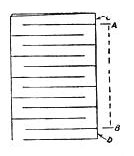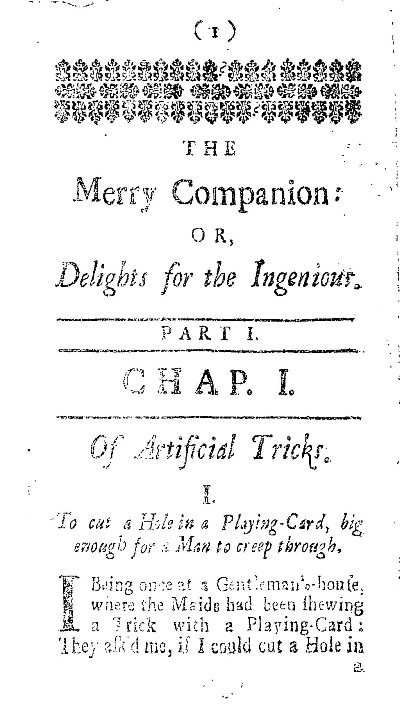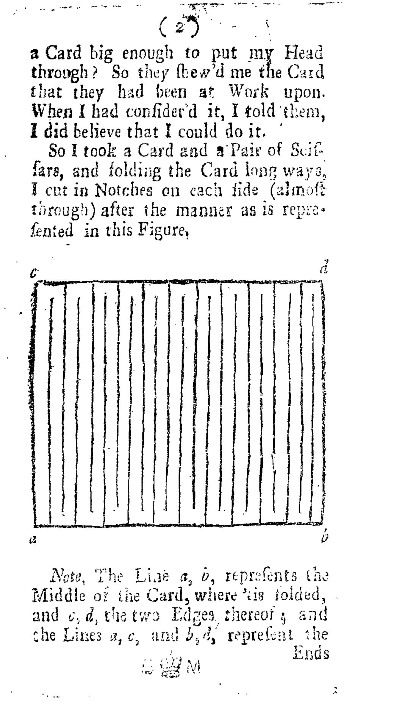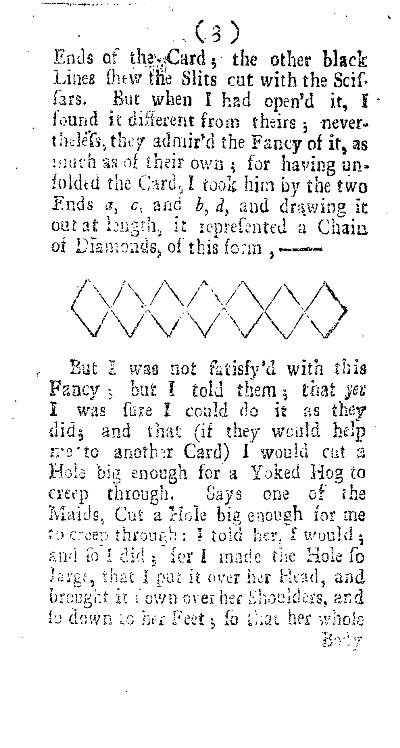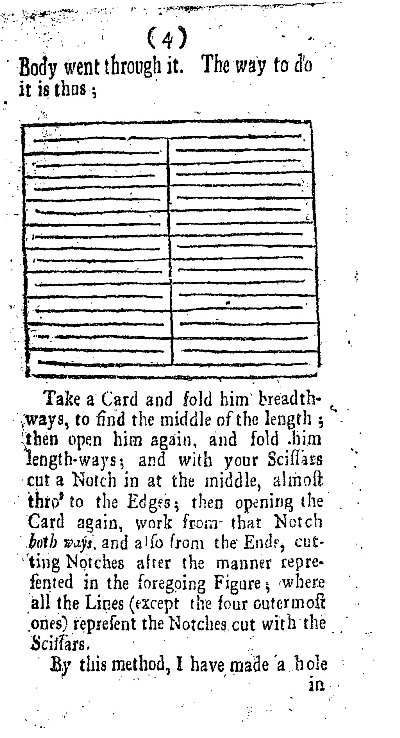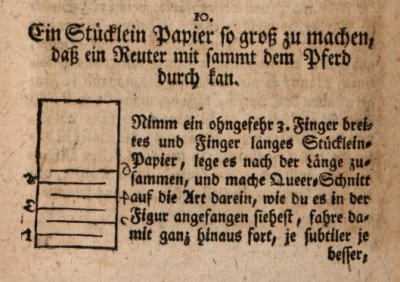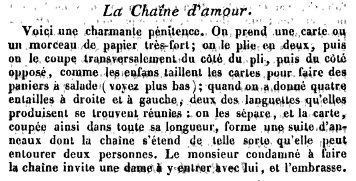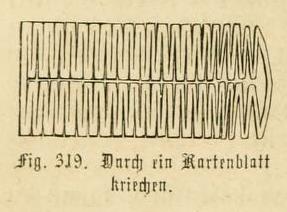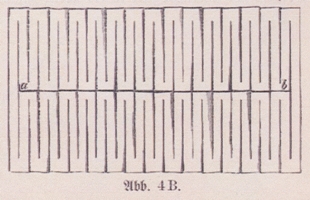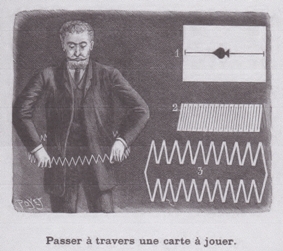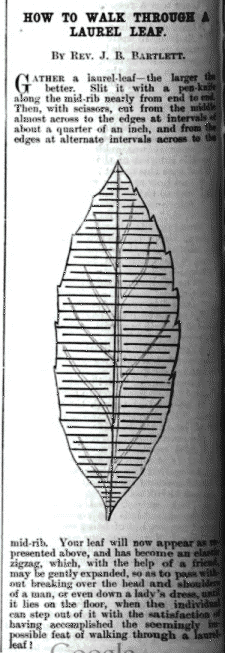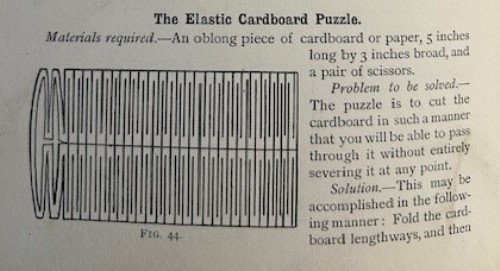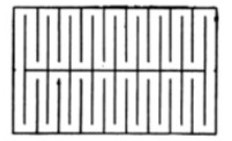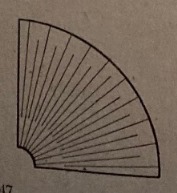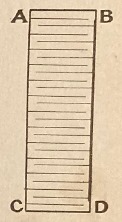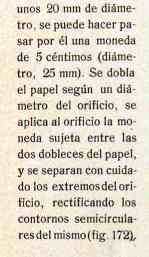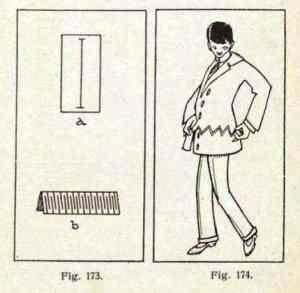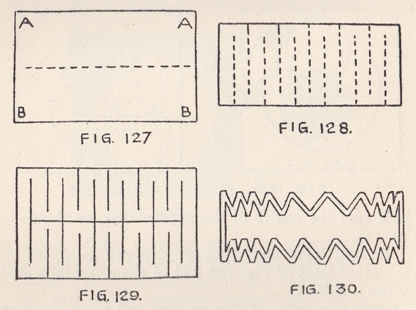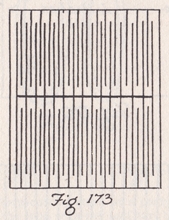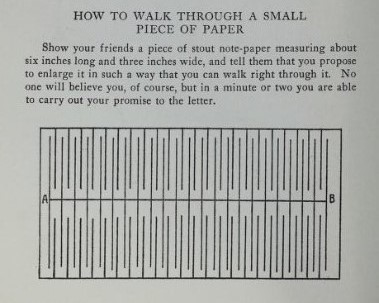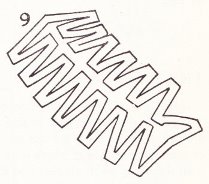| The Public Paperfolding History Project
Last updated 25/3/2025 x |
|||||||
| How to Climb Through a Playing Card | |||||||
This page is being used to collect information about the history of the fold and cut effect known as How to Climb Through a Playing Card. Please contact me if you know any of this information is incorrect or if you have any other information that should be added. Thank you. ********** In China (and in publications by Chinese authors) 1934 This effect appears as 'Paper Cut Ring' in 'Zhezhi Xinfa' (New Ways to Fold Paper), which was published by The Commercial Press in China in 1934.
********** In Europe and the Americas 1716 A clear description of this effect appears in 'The Merry Companion' by Richard Neve, which was published in London in 1716.
********** 1762 Part Five of 'Die Zehenmal Hundert und Eine Kunst' by Albrecht Ernst Friedrich von Crailsheim, which was published in 1762, contains a section titled (in translation) 'To make a piece of paper so big that a rider can get through with the horse.'
********** The effect also appears: 1827 In 'Manuel Complet des Jeux de Société' by Elisabeth Celnart (a pseudonym of Elisabeth Félicie Bayle-Mouillard née Canard) was published by La Librairie Encyclopedique de Roret in Paris in 1827. Here the effect is presented as a forfeit in which a playing card is folded and cut to produce a continuous chain which is long enough to allow two people to climb into the middle and kiss.
********** 1863 In 'De Kleine Papierwerkers: Volume 4: Het Knippen en plakken' (Cutting and Pasting), written by Elise Van Calcar and published by K H Schadd in Amsterdam in 1863, which contains a description, but no illustration, of how to crawl through a square of paper.
Parts of this passage say, roughly, 'Would you be able to crawl through this little sheet? Come, I will teach you this magic, - fold a square in the middle and cut a strip from the open side as if you were removing it but stop so that the strip stays in place. When the whole sheet has been cut with parallel cuts then you make cuts on the fold that divides the sheet in two. Cut all the strips except the bottom ones, they form the edge - and, behold, the sheet ...turned into a chain through which Henri and Ida could easily crawl.' ********** 1864 In 'Spielbuch fur Knaben' by Hermann Wagner, which was published by Verlag von Otto Spamer in Leipzig in 1864.
********** 1869 In 'De Kleine Natuurkundige' by Pieter Beets, which was published by D Noorthoven Van Goor in Leiden. The work is undated but said to be from 1869.
********** 1874 In 'Spiel und Arbeit' by Hugo Elm, which was published by Verlag und Drud der Otto Spamer in Leipzig in 1874.
********** 1876 In 'Des Kindes Erste Beschaftigungsbuch' by E Barth and W Niederley, which was first published in Bielefeld and Leipzig. The foreword is dated October 1876.
********** 1881 In 'Het Vlechten' by Elise Van Calcar, which was published by A.W. Sijthoff in Leiden in 1881 and is closely based on the earlier 'Des Kindes Erste Beschaftigungsbuch' by E Barth and W Niederley. The illustrations are the same drawings as had been used in the earlier book.
********** 1890 In Volume 1 of 'La Science Amusante' by Tom Tit (real name Arthur Good), which was published in Paris by Librairie Larousse in 1890.
********** As 'How to Walk Through a Laurel Leaf' by Rev. J. B. Bartlet in issue 587 of the 'Boy's Own Paper' for 12th April 1890. Note that this version of the effect is made without first folding the leaf in half.
********** 1891 In 'Pleasant Work for Busy Fingers' by Maggie Browne, which was published by Cassell and Company in London in 1891. The Preface states that, 'while not a mere translation', the book is based on 'Des Kindes Erste Beschaftigungsbuch' by E Barth and W Niederley. ********** 1894 As 'Une ceinture faite avec un morceau de papier' (A belt made with a piece of paper) in 'La Nature' Issue 1093 of 22nd June 1894 ********** 1900 As 'Anneaux Elastiques' in 'Mes Jolie Jeux' by Henriette Suzanne Bres was published by Librairie Hachette in Paris in 1900.
********** 1902 As ' 'Le Passage a Travers une Carte de Visite' in an article by Alber in the French children's magazine Mon Journal of 8th March 1902 ********** 1904 As 'The Elastic Cardboard Puzzle' in The Book of Indoor Games' by J K Benson, which was published by C Arthur Pearson Limited in London in 1904.
********** 1907 In issue 1503 of 'The Boy's Own Paper' of 2nd November 1907. Note that this version of the effect is made without first folding the paper in half.
********** 1908 In two forms, from a circle folded into quarters and a carte de visite folded in half, under the title 'Moyen de passer au travers d'une carte de visite', in 'Les Petits Secrets Amusants' by Alber-Graves, which was published by Librairie Hachette in Paris in 1908.
********** 1918 In 'Ciencia Recreativa' by Jose Estralella, which was published by Gustavo Gili in Barcelona in 1918.
********** 1923 As 'Multum Per Parvum' in 'More Paper Magic' by Will Blythe, which was first published by C Arthur Pearson in London in 1923.
This book also describes how to glue several 'Multum Per Parvums' together to make a garland. ********** 1928 As 'The Big Hole in the Small Piece of Paper' in 'Fun with Paperfolding' by William D Murray and Francis J Rigney was published by the Fleming H Revell Company, New York in 1928.
********** 1932 As 'Cutting A Hole' in 'Winter Nights Entertainments' by R M Abraham was first published by Constable and Constable in London in 1932
********** 1936 In 'Allerlei Papierarbeiten' by Hilde Wulff and Carola Babick, which was published in Leipzig and Berlin in 1936.
********** 1939 As 'How to Walk Through a Small Piece of Paper' in 'Fun with Paper' by Joseph Leeming, which was published by Spencer Press Inc in Chicago in 1939.
********** 1960 As 'The Expanding Card' in 'Paper Folding Fun' by Robert Harbin, which was published by Oldbourne in London in 1960.
********** 1963 As 'Stepping Through a Playing Card' in 'Fell's Guide to Papercraft: Tricks, Games and Puzzles' by Walter B Gibson, which was published by Frederick Fell Inc in New York and George McLeod Ltd in Toronto in 1963.
********** |
|||||||
